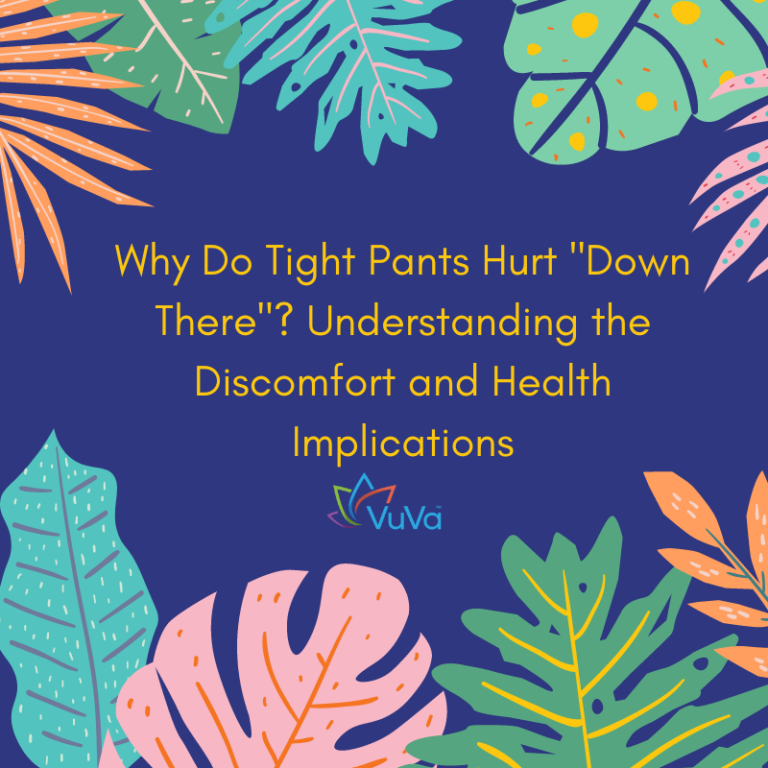Skinny pants, especially jeans, have been a fashion staple for decades. However, many women feel discomfort and even pain when wearing them. This discomfort can significantly affect daily activities, especially for those who lead an active lifestyle or experience menopausal symptoms. But why do tight pants hurt “down there”? In this blog post, we’ll explore the anatomical and health-related reasons behind this issue and provide practical advice on how to choose comfortable yet stylish clothing that supports your health.
Understanding Anatomy
To understand why tight pants can cause discomfort, it is necessary to have a basic understanding of the female reproductive system and the anatomy that surrounds it. The vulva, which includes the external genitalia, is particularly sensitive and susceptible to irritation. Tight clothing can exacerbate this sensitivity by causing friction and moisture trapping, leading to various forms of discomfort and health problems.
The effects of tight pants on health
Friction and Irritation
One of the main problems with tight pants is the friction they create on the vulva. Dr. Tami Rowen, an obstetrician at UCSF Medical Center who specializes in sexual health, explains that tight pants can rub against the vulva and cause irritation. This irritation can manifest as itching, redness and general discomfort. In some cases, the irritation can be mistaken for an infection because the symptoms are so similar.
Yeast infections and bacterial overgrowth
While tight pants alone are unlikely to cause yeast or bacterial overgrowth, they can contribute to an environment that promotes such growth. Tight pants reduce breathability, trapping heat and moisture in the vaginal area, which can encourage yeast and bacteria to thrive. According to Dr. Rowen, what you wear under your tight pants, such as synthetic underwear, plays a bigger role in this matter.
Nerve compression
Tight clothing can also compress nerves in the pelvic area, leading to pain and discomfort. This is of particular concern to women who already have conditions that affect nerve sensitivity. Prolonged compression can lead to chronic pain and other complications.
Menopausal women and tight clothing
Menopausal women often face unique challenges when it comes to clothing choices. Hormonal changes during menopause can lead to increased sensitivity and dryness in the vaginal area, making it even more important to choose clothing that minimizes irritation. Tight pants can aggravate these symptoms, leading to significant discomfort.
Tips for menopausal women
- Choose breathable fabrics: Choose pants made from breathable materials like cotton to reduce moisture build-up.
- Avoid synthetic underwear: Synthetic materials trap moisture, so choose cotton underwear for better airflow.
- Consider Looser Fits: Straight or relaxed trousers can offer more comfort without compromising on style.
-
Pelvic floor treatment for atrophy: If you are experiencing pelvic discomfort or painful sex, the VuVa magnetic dilator home treatment can help. VuVa magnetic vaginal dilators are used to regenerate vaginal capacity, expand vaginal walls, add elasticity to tissues and for comfortable intercourse.
Conditions for which vaginal dilators and vaginal trainers are recommended that may cause pain with tight pants:
- Vulvodynia
- Vaginitis
- Swimming
- Dyspareunia
- Pelvic radiation therapy
- Atrial stenosis
- Vaginal Atrophy
- Pudendal neuralgia
Choosing comfort over fashion
Fashion should never come at the expense of comfort and health. Here are some tips to maintain your style while prioritizing your wellness:
- Choose the right fabric: Choose natural, breathable fabrics like cotton or linen that allow air to circulate and reduce moisture build-up.
- Ensure proper fit: Avoid pants that are too tight around the waist and hips. Look for styles that offer a little more space without sacrificing style.
- We lay wisely: If you like skinny jeans, consider layering with plain cotton underwear to minimize chafing and irritation.
- Turn it on: Give your body a break by switching between tight pants and looser clothes like skirts or dresses.
Practical steps to keep your vagina happy
- Switch to skirts or looser pants: If you experience irritation, try wearing non-chafing skirts or pants for a while.
- Wear cotton underwear: Cotton breathes and reduces moisture build-up, making it a great choice for everyday wear.
- Change underwear often: If you have excessive discharge, change your underwear more than once a day or use a panty and replace it when needed.
- Consult your doctor or a pelvic floor physiotherapist: If you experience recurrent infections or severe irritation, see a healthcare professional to determine the underlying cause.
conclusion
While tight pants can be a fashionable choice, they can also lead to discomfort and health problems, especially in the sensitive vulva area. By understanding anatomy and the potential health implications, women can make informed decisions about their clothing choices. Prioritizing comfort and health doesn’t mean sacrificing style. with the right fabrics and fit, you can enjoy both.
The biggest problem may be a pelvic floor pain condition, which can be treated with pelvic floor therapy. Read this Q & A about vaginal atrophy and menopause. Your health and comfort are paramount, and together we can make choices that support our well-being.
